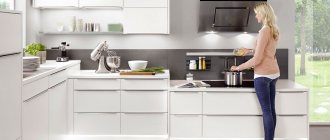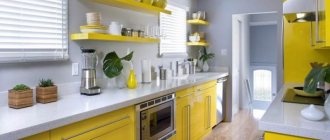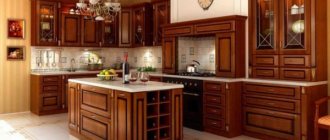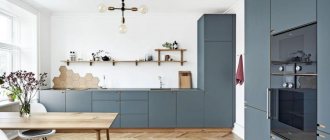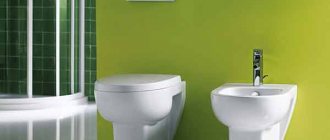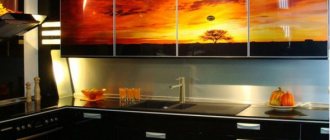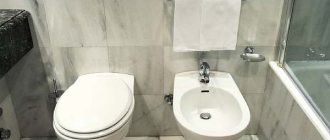Almost every housewife dreams of a functional kitchen. Manufacturers offer a huge number of headset models. Any consumer is given the opportunity to choose an option that is not only most convenient, but also corresponds to his taste preferences. Most modern furniture options use wall-mounted modules. To make it comfortable for a housewife to cook in the kitchen, it is important to arrange all the elements correctly. An important nuance is the height of the cabinets.
At what height should you hang kitchen cabinets?
Rules and standards
The generally accepted distance between the upper and lower kitchen cabinets is 50-60 centimeters. However, standards are not always applicable in life. When attaching wall cabinets in the kitchen, be sure to consider:
- tenant growth;
- ceiling height in the apartment;
- size of lockers;
- probable distance from the working surface to the upper exhaust line;
- purpose of cabinets.
The height of the residents in the apartment is the main factor determining where furniture is attached to the wall. The cabinet layout that is convenient for a tall person is not suitable for short people. The ideal option is to place a wall-mounted row of kitchen cabinets at eye level so that it can easily reach the shelves. When making calculations, keep in mind that the top of the cabinets should not be more than 25 cm higher than a person’s height.
Step-by-step instruction
In order to hang kitchen models on a mounting rail, you must do the following:
- Before starting installation, you need to remove the doors from the cabinets and secure the hook awnings.
- We lean the furniture against the wall at the required height, level it using a building level and mark the intended mounting location. Next, along the perimeter of the kitchen, we draw a line in the places where the cabinets are hung.
- We apply the mounting rail to the line and drill through the holes into the wall. Using a dowel, a bracket and a self-tapping screw, we fix the rail to the wall. Special washers should be used on the screws, since usually the holes in the rail are larger than the heads of the screws.
- We hang the frames on the rail and level them. If necessary, you can fasten them together.
- Next, we hang the doors and adjust them.
The rail on which furniture is hung.
To hang it on the corners, we perform the following steps:
- We attach the corners to the wooden cabinets;
- we measure and, using a building level, mark the vertical boundaries of the cabinets on the wall;
- We place the furniture against the wall at the required distance, align it and mark the attachment points through the hole in the ear;
- at the marked points we drill holes, hammer in dowels and screw in self-tapping screws;
- We hang the models on the self-tapping screws, insert the shelves, and then we need to attach and adjust the doors, attach the fittings, maybe on the table.
At what height should you hang kitchen cabinets?
The question in the article, at what height to hang kitchen cabinets, can be simply answered so that it is convenient to place and remove from them what is stored in them. This is true, but it is the same thing that means from a scientific point of view, which is convenient. I will formulate two rules that seem reasonable to me.
Rule 1
The hinge height of kitchen cabinets should be such that the smallest (adult) person at home can reach the top shelf of any work cabinet (shelf) without effort or support.
Please note that GOST 13025.1-85 “Home furniture. Functional dimensions of storage compartments”, this size is limited to 1900 mm.
Despite the fact that this GOST applies to furniture manufacturers, the height of 1900 mm seems quite reasonable to me, both from the point of view of ergonomics and from the point of view of common sense. Proper assembly and hinges of kitchen cabinets mean ease of use, and it would be strange to hang cabinets so that they can be reached by a stool on the top shelves.
The question arises, why was the height chosen for the top shelf and not the top of the wall cabinets? Firstly, the tops of cabinets are not places to store things, and secondly, the kitchen may have decorative cabinets (hoods), the height of which has nothing to do with ergonomics.
Rule 2
The height of the hinge of kitchen cabinets should be such that the “housewife,” standing next to the cabinets, can see what is on the top shelf without raising her head.
This is a controversial rule, but alternatively it is related to usability. In ergonomics, it is important that a person makes as few unnecessary movements as possible and takes fewer unnatural postures.
For example, a kitchen base cabinet that is too low for tall people will cause back strain, while a cabinet that is too tall for short people will cause problems when cutting food.
Installation nuances
- Before starting installation, stock up on the necessary tools. For brick walls, a simple drill will do, but if the walls are concrete, then you will need a hammer drill.
- Do not choose fasteners that are too large to attach.
- When drilling a hole in the wall, take into account the thickness of the plaster layer. We must not forget that the dowel should be in the brick, and not in the plaster. The size of the hole in the brick must be at least 5 cm so that it can be screwed in freely.
- Try not to hang cabinets on drywall, as such structures are unreliable.
- It is not recommended to overload mounted models.
All sizes, both walls and floors, should be considered individually. Repairing kitchen units is not a difficult task, and adjusting the hinges is not difficult; if you cannot entrust the work to professionals, do not be afraid and do the installation yourself. The main thing is to read the article carefully and there will be no problems.
Fastenings for hanging kitchen cabinets
When everything has been calculated and the most suitable level of the strip for hanging the cabinets has been selected, special attention should be paid to the reliability of their fastening to the wall.
It is necessary to take into account that the fastenings will support not only the weight of the model itself, but also the contents. They must be very reliable so that the kitchen set does not fall on a person one day.
Also no less important is the installation technology and fasteners, because if you follow it, you won’t have to waste extra effort and time. With the right choice of fastening and compliance with technological aspects, hanging cabinets is not a difficult task.
There are several ways to hang cabinets, and you should choose the one that is suitable for the material from which both the walls and furniture are made.
Hanging the upper sections yourself is not as easy as it might seem at first glance
Hanging corner
This method is the oldest, but at the same time the most effective and good. This method dates back to Soviet times.
This fastening system is very reliable.
Take a metal corner with two holes at the edges. One edge is fixed to the top of the furniture using a nut and bolt, and the second is attached to self-tapping screws, which are screwed into a dowel installed in the wall.
Fastenings for kitchen units
Rack with attachment
Another common way to hang kitchen models is a hanging rail. It consists of two elements: a metal mounting rail and a metal hinge, enclosed in a plastic case and having a hook for attaching to the rail.
It is attached to the wall with dowels and self-tapping screws to the standard required height.
A hanging rail is the most suitable way to attach furniture to walls made of cinder concrete, gas silicate and plasterboard.
Standard sizes of kitchen units
As already noted, kitchen furniture can be placed on the upper and lower levels. Their typical size was determined taking into account the average physiological characteristics of a person, mainly his height.
Kitchen unit dimensions
GOST regulates standards for certain sizes of interior items installed in the kitchen.
Table. A set of standards for kitchen furniture.
Parameter size, mm
| Module height (including table top) | 850… 900 |
| Working surface depth | 600 |
| Depth of the lower cabinet (internal), not lower | 460 |
| Wall module depth (internal), not less | 270 |
| Height from floor to top shelf of wall cabinet, no more | 1900 g |
Kitchen cabinet sizes
In practice, the parameters of the furniture offered to the consumer often differ slightly from the specified values.
Dimensions of lower modules
Furniture modules
When buying standard furniture, you need to pay attention to the following features:
- optimal overall height of the bases: 85... 95 cm. This also takes into account the thickness of the tabletop, which varies from 2 to 5 cm (depending on the model and material from which the tabletop is made);
- the depth of the desktop surface is usually 60 cm;
- the tabletop can protrude 5 cm from the facade, and the tabletop can protrude from the back wall by the same distance;
- cabinets can have a plinth at the bottom of 8... 10 cm;
- standard module depth: 50 or 55 cm;
- The width of the lower furniture is usually chosen from the range: 30, 40, 45, 50, 60, 80 and 90 cm.
Important! Recently, multi-level work surfaces have become popular among designers. This is due to the fact that it is more convenient for housewives to perform various operations when preparing food at different levels. For example, it is convenient to handle food at a height of 90 cm, wash dishes at a height of 100 cm and cook on a stove with a hob installed at a distance of 80 cm from the floor.
Dimensions of suspended structures
The standard sizes of the upper modules are also designed for the average housewife.
- Height: 60, 70, 80.90 cm (some manufacturers may also offer a cabinet with a height of 120 cm).
- The depth of the structures is usually 30 cm.
- Width standards correspond to the parameters of the lower cabinets.
Upper kitchen modules
The distance between furniture shelves can be 20 or 30 cm, although current rules specify a maximum element height of more than 190 cm, but even this parameter can be exceeded. In addition, wanting to make maximum functional use of the entire space of a small kitchen and install structures almost up to the ceiling, many deliberately resign themselves to possible difficulties.
Despite the accepted standards for wall cabinets, taking into account the ease of their operation, if the owner of the apartment wishes, it is possible to install higher structures. Frequent use of upper shelves in them is not very convenient, especially for those who cannot boast of significant height.
Case size and ease of use
However, in kitchens with high ceilings, furniture often fills up all possible space to accommodate food and items that do not need to be used as often. To get what they need, many people use small ladders or stools.
Today, interesting solutions are offered for organizing access to areas of hanging cabinets. For example, the installed electric drive allows you to lower the top shelf to the required distance after pressing a button (in some models you can simply pull the handle).
Lifting system for kitchen furniture
A removable ladder (after pressing the button with your foot) from the lower cabinet also helps, if necessary, to manage all the compartments of the wall cabinet. In this case, there is a big design flaw - the device hidden in the module takes up space that could be used for storing kitchen utensils or installing equipment. Models have also been developed that can be folded into boxes.
Retractable ladder
The design of a kitchen set may involve various ways of installing wall-mounted structures:
- at the same height;
- at different distances from the ceiling and tabletop.
Of course, if there is such an opportunity, it is more convenient to order furniture with individual parameters. In this case, you can easily take into account the wishes of the hostess and use the available space as functionally as possible.
Do-it-yourself wall cabinet mounting
You can install the upper modules of the kitchen unit yourself, without resorting to the services of professional teams. To do this, it is important to have the necessary tool and have minimal skills to work with it. In addition, it is necessary to consider the fastening system.
Fixing the cabinet on the wall can be done in two ways:
- on the mounting rail;
- using loops (or corners).
Kitchen Cabinet Fasteners
The first method, despite the more expensive parts, is considered the most reliable and convenient. All work can be done alone, and aligning the modules is easier. Dismantling of structures suspended on the bar is also easy.
Installation of kitchen cabinets on a strip
Important! The work of installing cabinets should be taken responsibly, since incorrect calculations can worsen the perception of the entire installed set, and poor fastening can cause the collapse of the structure.
To install the upper modules, you need to prepare the following tools and accessories:
- perforator;
- screwdriver;
- level;
- tape measure, pencil.
Installation will be carried out on a mounting rail. Planks are available in various lengths: 0.5, 1 or 2 m. They have special holes intended for fastening.
To fix the cabinet, universal canopies are used (2 pieces per cabinet).
The great advantage of such devices is the ability to adjust the installation level of the cabinet in terms of reach and height. Canopies can be right or left, as well as universal.
In addition, you will need self-tapping screws: with dowels for mounting the tire (for greater reliability, you can replace them with anchor bolts) and for attaching canopies.
Step 1.
Tire installation markings are made using the level. The bar itself can be broken off using the notches on it. Many people use separate tires for each canopy for installation. However, for convenience, it is recommended to mount a solid rail across the entire width of the modules. This will immediately ensure the correct installation level.
Marking the tire installation using a laser level. Marking fastening points
Step 2.
The plank is applied horizontally to the wall, points for fastening are marked. It is important to familiarize yourself with the location of the wiring in advance, otherwise if it is damaged by a drill, big problems may occur.
Step3.
To fix the tire, you need to drill holes. The wall can be made of different materials. The vast majority of load-bearing structures are made of reinforced concrete. The cabinet is installed on such bases using dowels with a diameter of 6 mm and self-tapping screws of 4 mm.
Drilling holes
Step 4.
The resulting debris is removed from the recesses. Dowels are driven into the holes. A mounting rail is supplied. Use a screwdriver to tighten the screws.
Screwing in self-tapping screws
Step 5.
Adjustable canopies are fixed to the side walls of the hinged module (from the inside). To make room for the hook, you need to make slits in the back wall. To do this, you can remove the hardboard or plywood from which it is usually made and make cuts. After this, the sheet is screwed back. It is possible to go the other way: use a pen attachment and use a drill to make holes in the back cover without removing it.
Slots in the back wall of the cabinet can be made with a jigsaw or hacksaw
Fastening the back wall of the cabinet
Step 6.
Canopies are being installed. To attach them, you need self-tapping screws 3 cm long (their diameter is usually 3.5 mm). Longer fasteners may pierce through the cabinet material. To fix each canopy you need 2 screws.
Fixing awnings
Step 7.
The cabinet is hung on a rail using hooks.
Hanging a cabinet
You can pull it closer to the wall by tightening the end bolt.
Adjustment by tightening the bolt
Now the cabinet will not be able to jump off the mount, even if it is accidentally lifted a little. Height adjustment is carried out using the second bolt.
Height adjustment
The wall cabinet is securely mounted on the kitchen wall.
In order for the dimensions of kitchen structures to best meet the requirements of household members, it is recommended to order designs according to your individual requirements. However, this option is more expensive. If you want to save money, you can purchase standard modules. In this case, you need to consider the proposed options and carefully calculate the installation method to choose the optimal one.
Important nuances to consider when choosing height
Important aspects of determining height are:
- adult height;
- dimensions of the upper modules;
- dimensions of the lower bedside tables;
- hob position.
You need to start first with the dimensions of the furniture elements, so you should purchase them after preliminary calculations on the possible location and convenience for family members. You can check the ergonomics of the wall right at the point of sale and choose the configuration of the shelves. Ideally, the tallest one should be accessible to all adults and at least the tallest members of the family. It is important to determine the ideal height of the apron for the kitchen. If nothing interferes with the ease of working with the sink, cutting surface and hob, you can leave only 45 cm on this element. This option is also acceptable for tall people. Also, do not forget about the spaciousness of both rows of the headset, and even more so “sacrifice” it for the sake of the presence of upper shelves.
Cabinet sizes
Typical parameters of wall cabinets for a kitchen wall are within the following limits:
See also: Selected ideas for decorating tree branches with your own hands
- height - 35-70 cm;
- width - 15-80 cm;
- depth - 25-45 cm.
The height of the suspended level depends on the size of the sections. And this applies not only to the upper part, but also to the lower elements of the headset. The standard height of the lower level is 80-95 cm and consists of the height of the base, frame and thickness of the tabletop. The depth of base cabinets is usually 55-60 cm, but can be 10 cm less or more. The tabletop protrudes beyond the edge of the curbs by 3-5 cm. The lower border of the hanging structure is selected taking into account the above characteristics. As for the upper cabinets themselves, regardless of their height, it is customary to line them up along the top edge. It is undesirable for the bottom shelf of short drawers to be higher than 80-90 cm above the tabletop. A chest of drawers with a height of 70 cm is hung so that the bottom edge is no more than 65 cm from the tabletop, and 55 cm is a convenient option for most people. The second and third shelves should be at the optimal and maximum placement heights, respectively.
Dependence on hood and stove
It is not recommended to install cabinets above the stove itself, but you can do this above the hood. This solution has already become a classic in the interior. When installing, take into account the minimum permissible height of the hob - 60 cm. It is most likely impossible to hang the cabinet flush with the adjacent sections. However, this is not all the difficulties: when heated, some materials release dangerous compounds. Treated wood (such as chipboard) can release formaldehyde and phenols when heated. The positioning height also depends on the insert type. It is advisable to leave a margin of 65-70 cm above electric and at least 75-80 cm above gas. At this level it is recommended to place only the hood and lockers slightly higher. To place furniture modules above the hood, special configuration options are provided.
Cabinets above the working surface of the hood practically do not increase the usable space - they usually have little space.
Taking into account a person's height
The height of adult hosts must be taken into account. We accurately measure the average. In addition, if only one person cooks regularly in the kitchen, then average height does not need to be taken into account. However, the lower the shelves, the easier they are to use, regardless of the purpose for which they are used. So, if the average adult height is less than 178 cm, we place the bottom edge of the cabinets at a height of 155 cm from the floor. With an indicator within the range of 178-185 cm, the sections are hung at a level of 160 cm. With a higher average height, the bottom of the modules should be in the corridor of 160-175 cm, in proportion to the result obtained. It is desirable that the upper shelves are located no more than 20-25 cm above the head of the lowest adult. Shelves higher than 210 cm from the floor do not work. The minimum placement at the bottom of hanging level furniture is 135 cm, but some recommend setting them at least 145-150 cm for people of average height.
Work surface with different levels
Consumers are increasingly choosing multi-level countertops. It is not only beautiful and convenient, but also very practical:
- during long cooking, the housewife does not feel tired, since the muscles of the buttocks, arms, and back experience insignificant tension;
- the working surface is divided into several functional zones, which greatly simplifies cleaning;
- You can harmoniously and practically play around with a non-standard shaped room, increasing the usable space, integrating surfaces into niches or free corners, behind which it is convenient and comfortable to work.
The upper tier is positioned so that you can reach the second shelf without standing on your toes. It is important to take into account the distance from the lower tier to the cabinets located above. It should be at least 450 mm, which will allow you to arrange household appliances and kitchen appliances with utmost convenience. The acceptable distance between the floor and hanging tiers is 550-600 mm, taking into account the fact that the kitchen will be used by people of average height.
Height of base cabinets
The main kitchen cabinet is located on the floor and contains the stove, oven, dishwasher, as well as several pots, plates, bulk items and more. The dimensions of the base cabinets directly depend on the built-in appliances and affect the ease of use of the kitchen set.
For people of average height by human height standards, the most comfortable cabinets will be 85 cm high, which consist of:
- legs - 10 cm;
- the cabinet itself is 72 cm;
- tabletop thickness - from 28 to 40 mm.
Summarize
At first glance, installing a kitchen cabinet is not difficult. In fact, this is not so: the procedure will require taking into account several important parameters: the height of the kitchen owner, the location of the stove and hood, the size of the furniture itself. If installed incorrectly, the hanging elements of the kit will be inconvenient to use. If you are not sure that you can choose their location correctly, it is better to refer to the values established by GOST. It is designed in such a way that the furniture is comfortable for people of any height.
Installing fasteners on drywall covered with tiles
Ceramic tiles are laid on plasterboard reinforced with reinforced mesh. This coating significantly increases the load-bearing capacity of a wall or partition.
To install fasteners, mounting holes are made into the joints of adjacent tiles. If their diameter violates the integrity of the tile, use a special drill for ceramics and glass. Otherwise, the ceramic coating may break.
Dependence on hood and stove
The decisive point when hanging the hood is the distance from the stove. The instructions usually have a diagram with dimensions. If you do not have documents for the equipment, follow these rules:
- The minimum distance between the stove and the hob is 65-70 cm; at this distance there is no risk of flame contact with the device.
- Position the hood at the bottom so that cooking is not awkward even in the largest pots.
- Install the top of the hood at such a level that air is drawn in from all layers of the room.
The height of the position directly depends on the type of plate. If it is electric, it is permissible to hang the hood at a distance of 65 cm. For a gas stove, this figure increases to 70-75 cm. Usually the device is suspended at a height of 70 to 90 cm, held in it taking into account the height of the cook.
Built-in technology
For obvious reasons, light kitchen appliances are installed in the top row of furniture. First of all, this is a hood, a dish dryer, and in some cases a microwave or oven is built in.
- The microwave oven can be installed in an open cabinet or on a separate shelf; in addition, there are built-in models designed for installation with a facade. The microwave should not be placed near stoves or on the refrigerator.
- Hoods are installed at least 65 cm from electric stoves and 75 cm from gas stoves. If the hood is placed too low, the overall air circulation in the kitchen deteriorates, and hot air and smoke are poorly removed from the room.
- Dryers are placed either above the sink or not far from it. This item is sold in retractable cargo modules or in ordinary open cabinets with a bottom tray for water drainage.
Expert opinion
Svetlana Kolesnikova
Designer
A separate issue is the space above the refrigerator. If it is built-in, there will be no problems, but it is not always possible to fit an ordinary refrigerated cabinet harmoniously into the interior. It is possible to place all the hanging elements at the level of the device only if its size is more than two meters, and such a solution is not always feasible. Another option is to compensate for the difference with a narrow bedside table located above the camera on the same level as the rest of the wall cabinets.
Placing built-in appliances in the kitchen
Creating a favorable atmosphere in the kitchen
For most Russians, the kitchen is a favorite place in the house. Therefore, it should be as comfortable as possible. The atmosphere here affects not only the state, but also the actions of the people who are here. For example, if you are not satisfied with the arrangement of furniture in the kitchen, you can often get burned by a gas stove, as well as get hit by the corners of cabinets and their open doors.
Therefore, it is important to choose the right distance between the countertop and the furniture in the kitchen, and here are two points:
- The height of the working surface is selected so that the housewife can use it comfortably during the cooking process. At this point, your hands on the tabletop should form an angle of approximately 15-20 degrees. If this parameter is not observed, the hands quickly get tired, excessive force is caused by incorrect posture. Therefore, with a height of 165-185 cm, you can safely order lower bedside tables with a height of 820-900 millimeters.
- But the upper cabinets and their lower part should be slightly below eye level. With this arrangement it is more convenient to find the things you need inside. When we hang cabinets a little lower, we are likely to bump into their surfaces frequently.
Working surface height
The generally accepted height of floor modules is 850 mm. However, this indicator can be adjusted if you install twist-out legs on the furniture. But most often they choose a standard base. For people whose height does not exceed 178 cm, a support with a level of 100-120 mm is suitable, then the total height of the bottom row will be 800-850 mm, working behind such a surface is pleasant and comfortable.
For a person above average height, select a base with a level of 150-200 mm, then the working surface will be at a level of 900-950 mm. For people with disabilities or those whose height is up to 150 cm, the suitable working surface height is 760 mm.
The level of the lower tier is calculated based on the following indicators:
- depth of the working area (600-700 mm). The larger it is, the wider the viewing angle and the more pleasant it is to be in the kitchen;
- the distance between the lower and upper tier. It is important to position the upper modules in such a way that you do not hit your head on them during operation;
- the optimal gap between the hob and the sink is at least 400 mm. This will prevent splashes of water and detergent from getting into the soup pot.
Keep in mind that the height of the working surface is also affected by the thickness of the table top (usually it is 3-4 cm). The table top reaches the kitchen apron; the joint is masked using a wall edge or kitchen plinth. A free space of several centimeters is left between the cabinets and the wall, which is used for laying gas and water pipes, masking wires, etc.
Optimizing the distance for household appliances
A kitchen set is a complex integrated system of several modules. Most often, special auxiliary products are built in in the form of a washing machine, gas stove, etc. In some cases, this requires some adjustment to the distance between adjacent attributes.
This also affects the height of the opening from the countertop to the wall cabinet. There are several rules governing these distances for each specific element of this system:
- The electric stove must be at least 65 cm lower than the bottom of the first shelter located directly below it. These recommendations help reduce the influence of temperature on the structure of the material from which the set is made.
- The top cabinet of a gas stove should be placed at a distance of at least 70 cm, since such designs use open fire. These factors can cause not only wear and tear on the laminate surface, but also a direct fire.
Remember that if other modules are placed near these devices, it is necessary to ensure that the temperature influence on the structure of the materials related to them is minimal. Often the ends of the cabinets that will stand next to the stove are made of heat-resistant substances (metal, etc.).
How is it really?
People can still adhere to the standard of a lower recommended height of 450mm from the worktop to the bottom edge of the wall cabinet. It’s more expensive to go below this line: either the juicer won’t fit, or there’s not enough space for the food processor, or even worse - the covering of the upper cabinet door is cracked from the steam coming from the kettle. Everything is clear here.
But the upper limit is sometimes maliciously violated. The fact is that often in the kitchen it is not the average woman who operates the pots, but a man with gastronomic abilities and a boundless love for the kitchen. Perhaps a woman, but with a height suitable for volleyball. Neither cook will like the kitchen furniture, since it simply does not suit their height—the cabinets are hung too low.
You have to bend over to fully view the workspace, get food and dishes from the lower sections of wall cabinets, and so on.
Therefore, when planning places for attaching wall cabinets locally, you should take into account some physical characteristics of the person who will be in charge of the kitchen most often. In this case, human height is especially important. The following points can be considered other important factors:
- dimensions of the wall cabinets themselves;
- sizes of household appliances used;
- height of the ceilings of the room.
To calculate the height of wall-mounted cabinets, not only the height of these products matters, but also their depth. The greater the depth, the lower the height of their mounting on the wall.
Due to human growth, we can give the following recommendations on the optimal height for hanging shelves or cabinets:
- with growth up to 1.60-1.65 m, the height of the cabinet is from 1.70 to 1.75 m from the floor;
- if the height is within 1.65-1.75 m, then the cabinet mounting height is 1.80 m;
- height more than 1.75 m - cabinet at a height of 2.0 m.
In this case, the hanging height of the cabinet refers to its lower edge. You need to make sure that the ventilation hole is not covered by a cabinet.
In connection with the latest figures recommended for use when hanging shelves or cabinets in a kitchen set, adjusted for human height, the following distance indicators are obtained from the table surface to the lower edge of the hanging furniture elements:
- the standard shortest distance for a woman of average height (up to 1.6 m) is 450 mm;
- standard maximum (recommendation) distance – 600 mm;
- the recommended distance for a person with a height of 1.60 to 1.65 m is 800–850 mm;
- recommended distance for height from 1.65 to 1.75 m – 900 mm;
- The recommended distance for a person with a height of 1.80 m and above is 1100–1150 mm.
At the same time, we believe that the height of the kitchen worktop from the floor to the top surface of the tabletop has standard dimensions: 850–900 mm.
Distance between lower and upper cabinets in the kitchen
The deceptive impunity of arbitrary hanging of lockers has more than once led to domestic injuries. Many people try to free up space in the kitchen between the ceiling and the cabinet to place unnecessary items. And people don’t always think about what distance should be between the drawers or the bottom and the countertop.
Cabinet layout according to GOST standards
When kitchen sets were produced according to state standards, it was possible to roughly estimate that a large set was not suitable for a 5 m kitchen, and its height did not allow placement under a ceiling of 2.48-2.7 m.
The vast majority of kitchen wall cabinets were produced in small sizes only. Modern realities, the use of foam concrete in new buildings, numerous private houses with different parameters have led to the birth of furniture based on individual projects.
There were offers from Ikea. Here, kitchen items and cabinets can be stacked, like a children's construction set, in any order.
Drawing with standard dimensions of top and bottom drawers
Owners of custom kitchens think less about practicality and more about aesthetics and design. At the same time, they forget or do not know about the need to maintain the distance between kitchen cabinets, the top and bottom of the drawers.
See also: Size chart for men's and women's shoes: for children and teenagers
As a result, you can often find people on forums complaining about the inconvenience of a new kitchen. Some are looking for ways to optimize their work, suggesting that some flaws were made in the placement of new furniture.
Even with non-standard parameters of functional premises, an experienced furniture manufacturer takes into account certain dimensions. For example, the height of the lower tier of cabinets and countertops is limited to 90-100 cm.
Optimal location of the hood and stove in the kitchen
The location from the window is also taken into account, which allows you to freely open the sash or window.
The position of the countertop is also important when working with gas stoves.
Upper cabinets hit your head
The reason for the inconvenience is the narrow tabletop. When the tabletop depth is less than the standard 60 cm, the upper wall blocks, protruding 30-40 cm, overcome at least half of it. As a result, the owner rests her face on the top row of the headset or hits her head when tilting. The solution to the problem is to replace the countertop with a deeper one.
The reason may also be the low position of the wall cabinets. In this case, you will have to overcome taller furniture. The presence of an apron will cause some difficulties, since it is laid out along the lower edge of the upper cabinets. By lifting them you will get empty space.
Sources
- https://str-mebel.ru/stoly/rasstoyanie-ot-stoleshnicy-do-verhnih-shkafov.html
- https://oboiman.ru/inside/rasstoanie-mezdu-niznimi-i-verhnimi-skafami-kuhni-regulirovka-kuhonnyh-skafov-na-kakom-rasstoanii-vesat.html
- https://interior-experts.ru/kuhnya/kuhonnye-shkafy-rasstoyanie.html
- https://OmkMebel.ru/dizajn-interera/shkaf-mezhdu.html
- https://mebel-expert.info/na-kakoj-vysote-veshat-kuhonnye-shkafy/
- https://severdv.ru/mebel/kuhnya/kakoe-dolzhno-byt-rasstoyanie-mezhdu-shkafami-na-kuhne/
- https://nikastroy.ru/vysota-kuhonnyh-skafov-verhnih-niznih-standart-ot-pola-i-nad-stolesnicej/
- https://mebel-zeus.ru/poleznoe/ekspluatatsija-kuhonnoj-mebeli/rasstojanie-mezhdu-verhnimi-i-nizhnimi-shkafami-kuhni/
- https://vyborkuhni.ru/rasstoyanie-mezhdu-shkafami-kuhne
- https://mebelclubspb.ru/kuhnya/kakim-dolzhno-byt-rasstoyanie-mezhdu-verhnimi-i-nizhnimi-shkafami-kuhni.html
- https://ProNormy.ru/stroitelstvo/dizayn/rasstoyanie-mezhdu-verkhnimi-i-nizhnimi-shkafami-kukhni

